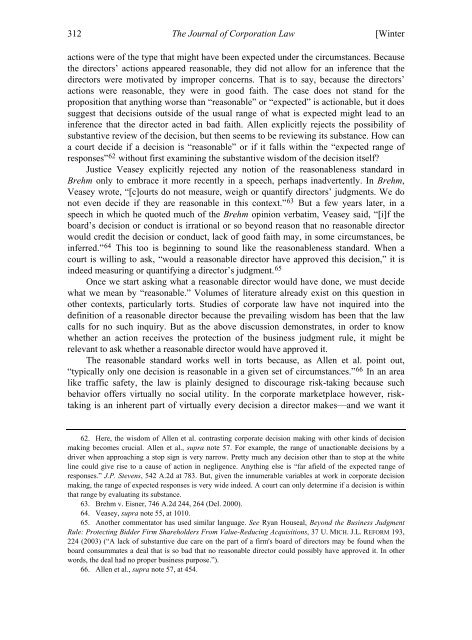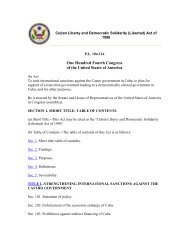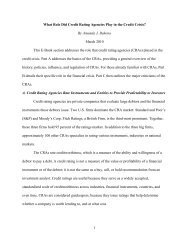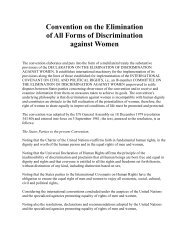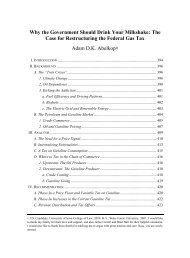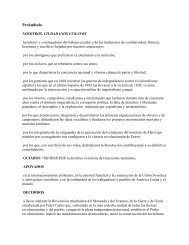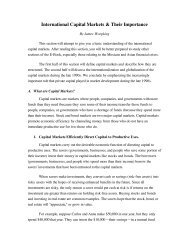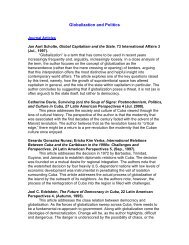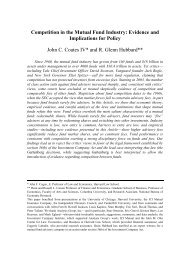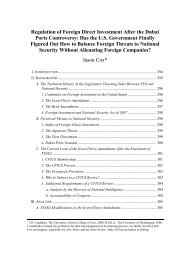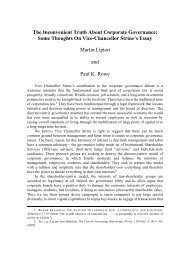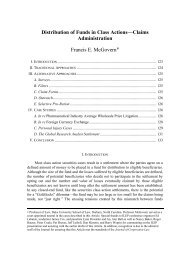Galactic Stupidity and the Business Judgment Rule - College of Law
Galactic Stupidity and the Business Judgment Rule - College of Law
Galactic Stupidity and the Business Judgment Rule - College of Law
You also want an ePaper? Increase the reach of your titles
YUMPU automatically turns print PDFs into web optimized ePapers that Google loves.
312 The Journal <strong>of</strong> Corporation <strong>Law</strong> [Winter<br />
actions were <strong>of</strong> <strong>the</strong> type that might have been expected under <strong>the</strong> circumstances. Because<br />
<strong>the</strong> directors’ actions appeared reasonable, <strong>the</strong>y did not allow for an inference that <strong>the</strong><br />
directors were motivated by improper concerns. That is to say, because <strong>the</strong> directors’<br />
actions were reasonable, <strong>the</strong>y were in good faith. The case does not st<strong>and</strong> for <strong>the</strong><br />
proposition that anything worse than “reasonable” or “expected” is actionable, but it does<br />
suggest that decisions outside <strong>of</strong> <strong>the</strong> usual range <strong>of</strong> what is expected might lead to an<br />
inference that <strong>the</strong> director acted in bad faith. Allen explicitly rejects <strong>the</strong> possibility <strong>of</strong><br />
substantive review <strong>of</strong> <strong>the</strong> decision, but <strong>the</strong>n seems to be reviewing its substance. How can<br />
a court decide if a decision is “reasonable” or if it falls within <strong>the</strong> “expected range <strong>of</strong><br />
responses” 62 without first examining <strong>the</strong> substantive wisdom <strong>of</strong> <strong>the</strong> decision itself?<br />
Justice Veasey explicitly rejected any notion <strong>of</strong> <strong>the</strong> reasonableness st<strong>and</strong>ard in<br />
Brehm only to embrace it more recently in a speech, perhaps inadvertently. In Brehm,<br />
Veasey wrote, “[c]ourts do not measure, weigh or quantify directors’ judgments. We do<br />
not even decide if <strong>the</strong>y are reasonable in this context.” 63 But a few years later, in a<br />
speech in which he quoted much <strong>of</strong> <strong>the</strong> Brehm opinion verbatim, Veasey said, “[i]f <strong>the</strong><br />
board’s decision or conduct is irrational or so beyond reason that no reasonable director<br />
would credit <strong>the</strong> decision or conduct, lack <strong>of</strong> good faith may, in some circumstances, be<br />
inferred.” 64 This too is beginning to sound like <strong>the</strong> reasonableness st<strong>and</strong>ard. When a<br />
court is willing to ask, “would a reasonable director have approved this decision,” it is<br />
indeed measuring or quantifying a director’s judgment. 65<br />
Once we start asking what a reasonable director would have done, we must decide<br />
what we mean by “reasonable.” Volumes <strong>of</strong> literature already exist on this question in<br />
o<strong>the</strong>r contexts, particularly torts. Studies <strong>of</strong> corporate law have not inquired into <strong>the</strong><br />
definition <strong>of</strong> a reasonable director because <strong>the</strong> prevailing wisdom has been that <strong>the</strong> law<br />
calls for no such inquiry. But as <strong>the</strong> above discussion demonstrates, in order to know<br />
whe<strong>the</strong>r an action receives <strong>the</strong> protection <strong>of</strong> <strong>the</strong> business judgment rule, it might be<br />
relevant to ask whe<strong>the</strong>r a reasonable director would have approved it.<br />
The reasonable st<strong>and</strong>ard works well in torts because, as Allen et al. point out,<br />
“typically only one decision is reasonable in a given set <strong>of</strong> circumstances.” 66 In an area<br />
like traffic safety, <strong>the</strong> law is plainly designed to discourage risk-taking because such<br />
behavior <strong>of</strong>fers virtually no social utility. In <strong>the</strong> corporate marketplace however, risktaking<br />
is an inherent part <strong>of</strong> virtually every decision a director makes—<strong>and</strong> we want it<br />
62. Here, <strong>the</strong> wisdom <strong>of</strong> Allen et al. contrasting corporate decision making with o<strong>the</strong>r kinds <strong>of</strong> decision<br />
making becomes crucial. Allen et al., supra note 57. For example, <strong>the</strong> range <strong>of</strong> unactionable decisions by a<br />
driver when approaching a stop sign is very narrow. Pretty much any decision o<strong>the</strong>r than to stop at <strong>the</strong> white<br />
line could give rise to a cause <strong>of</strong> action in negligence. Anything else is “far afield <strong>of</strong> <strong>the</strong> expected range <strong>of</strong><br />
responses.” J.P. Stevens, 542 A.2d at 783. But, given <strong>the</strong> innumerable variables at work in corporate decision<br />
making, <strong>the</strong> range <strong>of</strong> expected responses is very wide indeed. A court can only determine if a decision is within<br />
that range by evaluating its substance.<br />
63. Brehm v. Eisner, 746 A.2d 244, 264 (Del. 2000).<br />
64. Veasey, supra note 55, at 1010.<br />
65. Ano<strong>the</strong>r commentator has used similar language. See Ryan Houseal, Beyond <strong>the</strong> <strong>Business</strong> <strong>Judgment</strong><br />
<strong>Rule</strong>: Protecting Bidder Firm Shareholders From Value-Reducing Acquisitions, 37 U. MICH. J.L. REFORM 193,<br />
224 (2003) (“A lack <strong>of</strong> substantive due care on <strong>the</strong> part <strong>of</strong> a firm's board <strong>of</strong> directors may be found when <strong>the</strong><br />
board consummates a deal that is so bad that no reasonable director could possibly have approved it. In o<strong>the</strong>r<br />
words, <strong>the</strong> deal had no proper business purpose.”).<br />
66. Allen et al., supra note 57, at 454.


